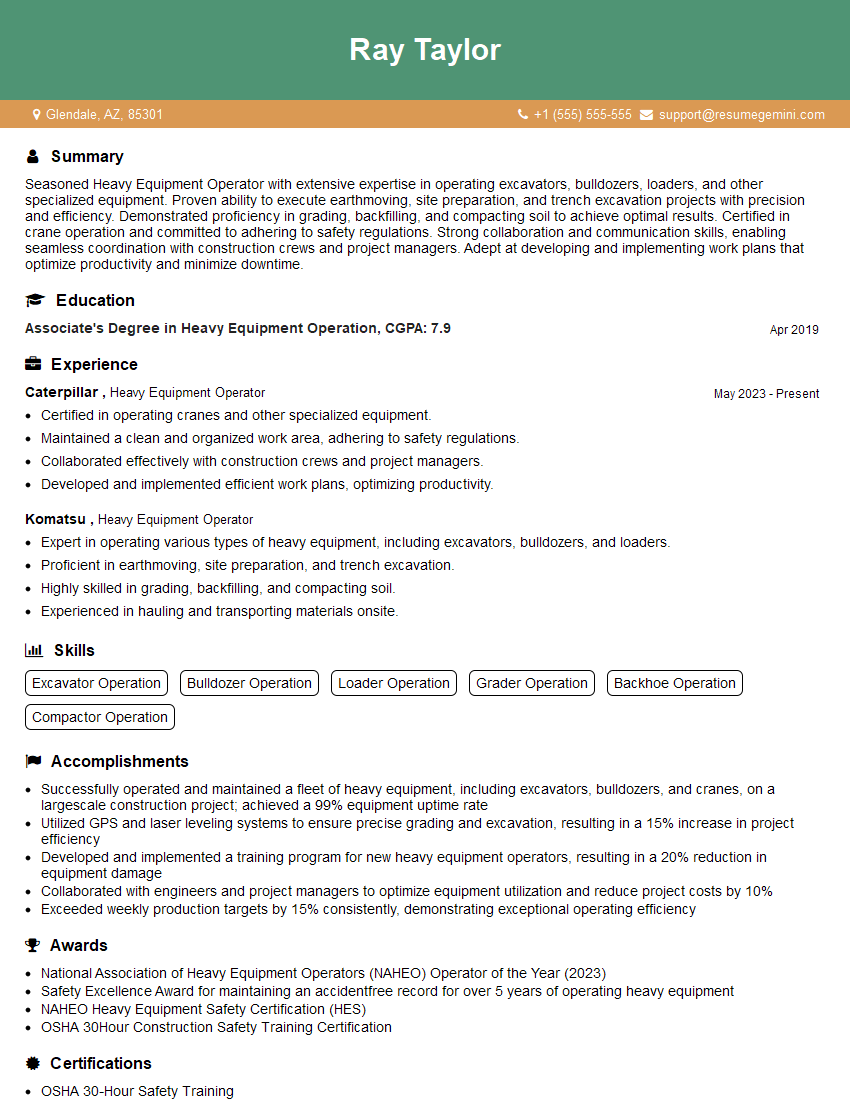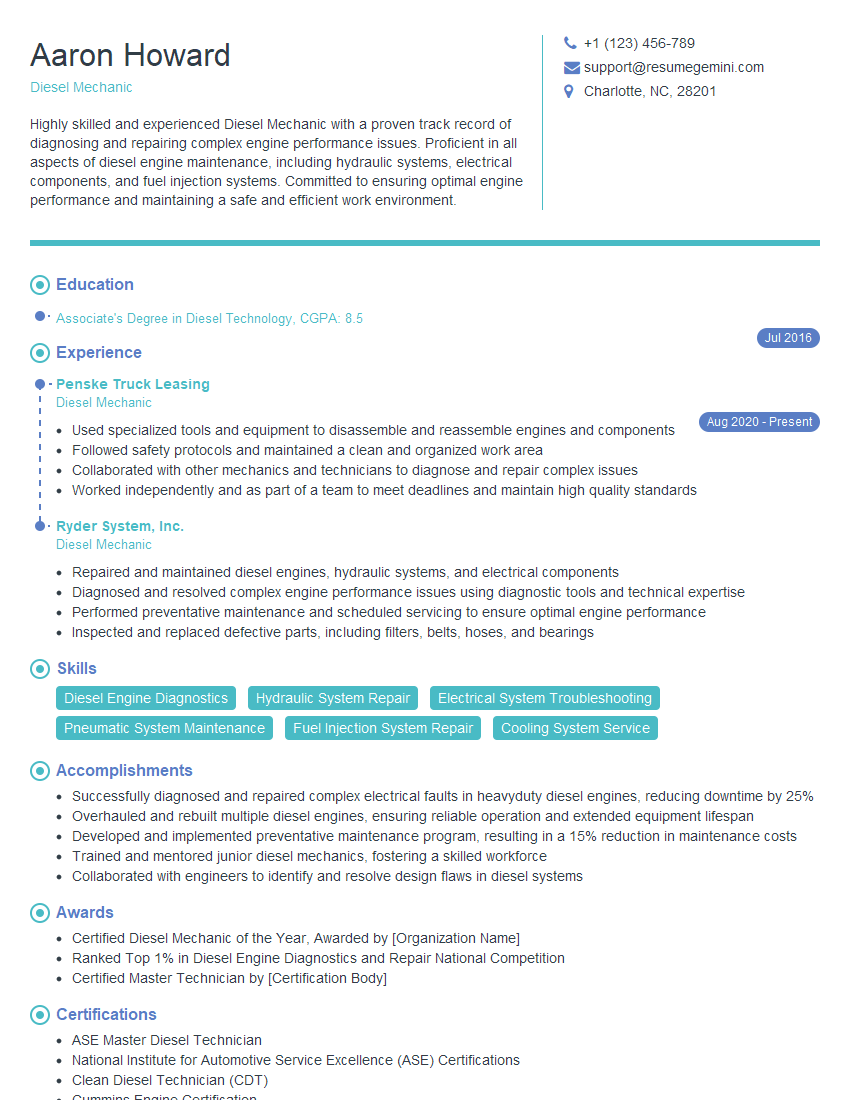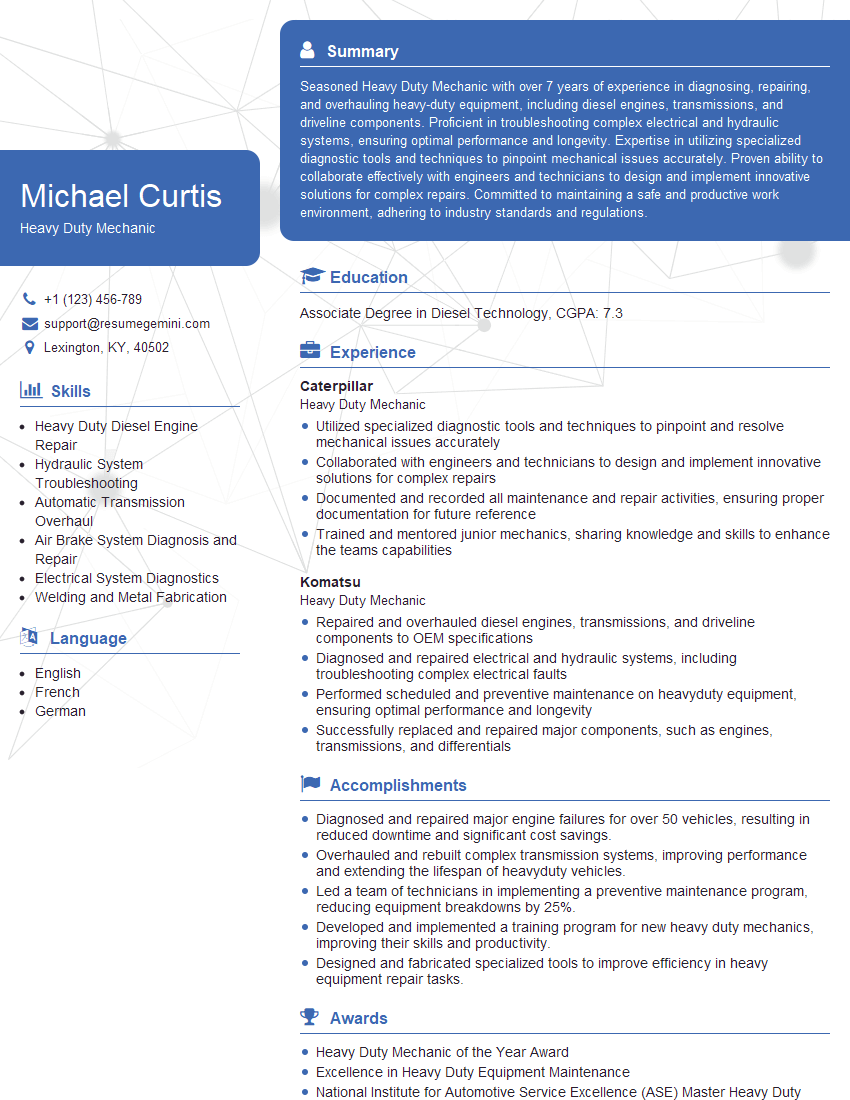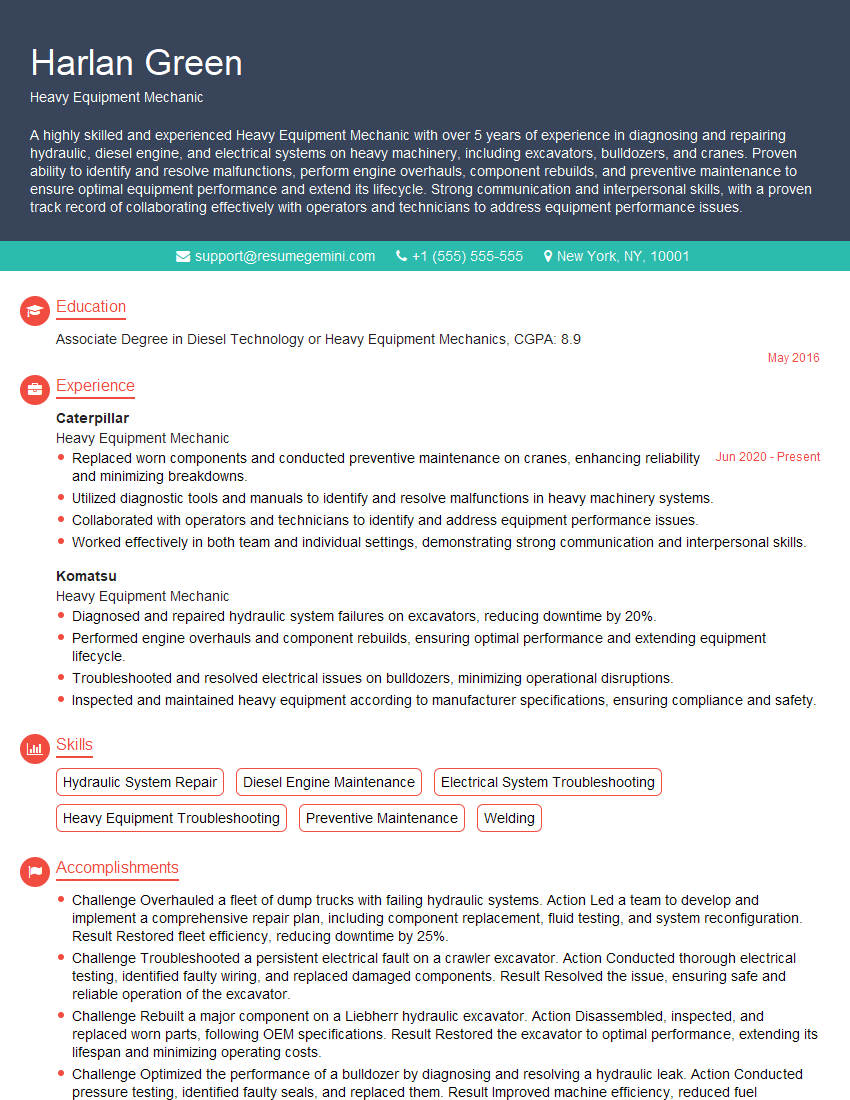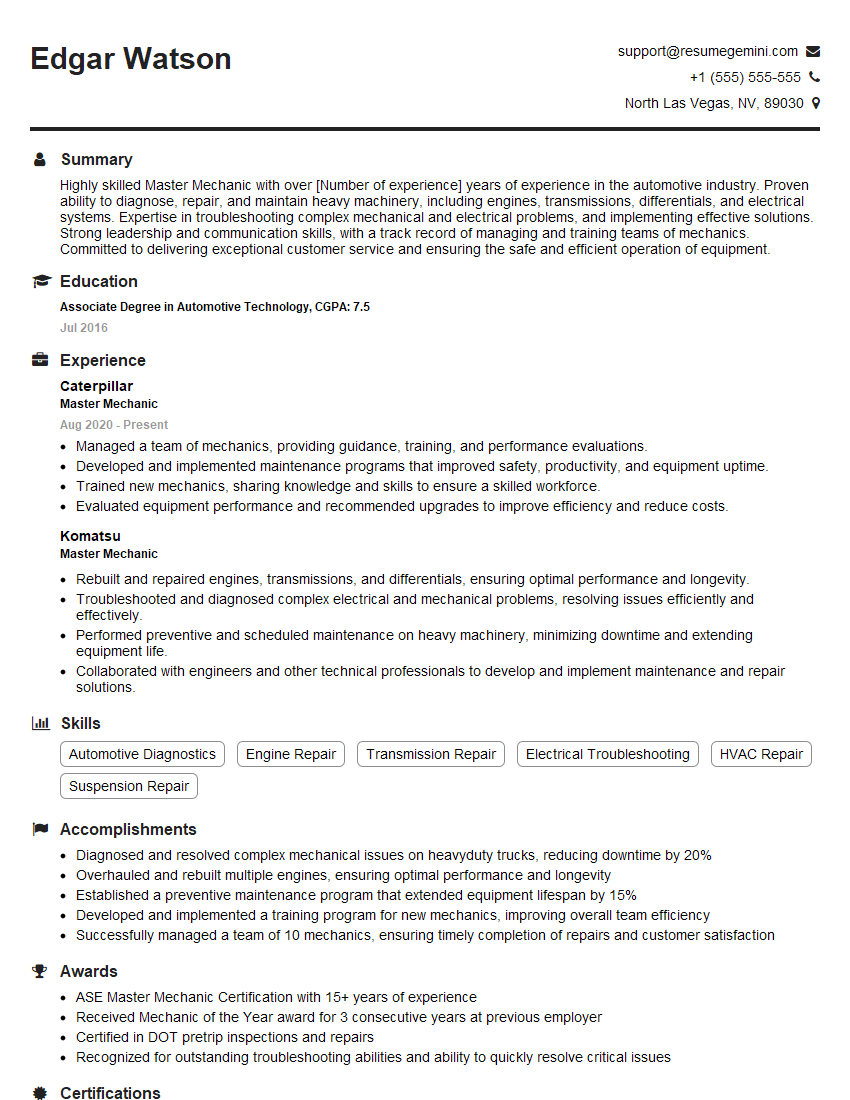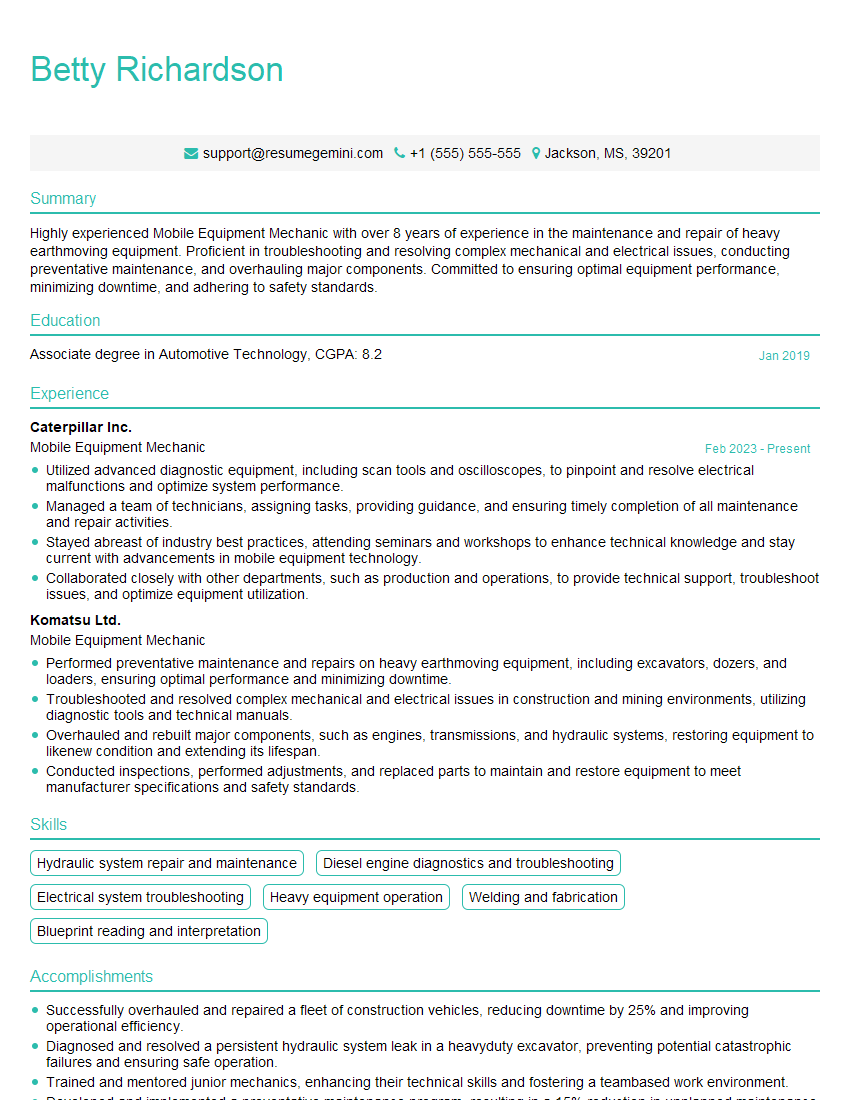Cracking a skill-specific interview, like one for Expertise in operating hydraulic systems and dump truck mechanisms, requires understanding the nuances of the role. In this blog, we present the questions you’re most likely to encounter, along with insights into how to answer them effectively. Let’s ensure you’re ready to make a strong impression.
Questions Asked in Expertise in operating hydraulic systems and dump truck mechanisms Interview
Q 1. Describe the components of a typical hydraulic system in a dump truck.
A typical hydraulic system in a dump truck uses pressurized fluid to actuate the lifting and tilting mechanisms of the truck bed. Key components include:
- Hydraulic Pump: The heart of the system, providing the pressurized fluid.
- Hydraulic Reservoir: Stores the hydraulic fluid and allows for cooling and air separation.
- Hydraulic Valves: Control the direction and flow of hydraulic fluid, directing it to different actuators. These can include directional control valves, pressure relief valves, and check valves.
- Hydraulic Actuators: These convert the hydraulic energy into mechanical motion. In a dump truck, these are typically hydraulic cylinders responsible for raising and lowering the bed, and sometimes for tilting it.
- Hydraulic Lines and Fittings: The tubing and connectors which transport the hydraulic fluid throughout the system. Leaks in these lines are a common problem.
- Hydraulic Fluid: The medium transmitting power within the system. The correct type is crucial for optimal performance and longevity.
Think of it like a complex network of pipes and tubes, with the pump as your heart, pumping fluid to specific locations (actuators) based on commands from the valves (like your brain controlling your muscles).
Q 2. Explain the function of a hydraulic pump in a dump truck.
The hydraulic pump’s function is to draw hydraulic fluid from the reservoir and pressurize it. This pressurized fluid is then directed by the valves to the hydraulic cylinders. The pump’s pressure generates the force necessary to lift and tilt the heavy dump truck bed. Different types of pumps exist, including gear pumps, vane pumps, and piston pumps, each with its own characteristics in terms of flow rate and pressure capability. A gear pump, for example, is often found in smaller dump trucks due to its simplicity and cost-effectiveness, while a piston pump is preferred in heavier-duty trucks requiring higher pressure and flow.
Imagine the pump as a powerful water pump in your garden, but instead of water, it pushes specialized oil to lift significant weight.
Q 3. What are the different types of hydraulic fluids and their applications?
Hydraulic fluids vary in their properties and are chosen based on the specific application and operating conditions. Common types include:
- Mineral Oil-based Fluids: The most common and relatively inexpensive. Suitable for many applications but can degrade more quickly under extreme temperatures.
- Synthetic Hydraulic Fluids: Offer better performance at extreme temperatures, extended service life, and better resistance to degradation. They are more expensive than mineral oils.
- Water-Glycol Fluids: These are environmentally friendly and often used in systems requiring fire resistance. They are less common in heavy-duty dump trucks.
The selection depends on factors such as operating temperature range, the presence of water or contaminants, and the required viscosity. For example, a truck operating in extreme cold would need a low-viscosity fluid to ensure proper flow, whereas one working in high temperatures requires a fluid with a high viscosity index to maintain its properties.
Q 4. How do you troubleshoot a hydraulic leak in a dump truck?
Troubleshooting a hydraulic leak begins with safety – ensure the system is shut down and the truck is secured. Then:
- Locate the Leak: Carefully inspect all hydraulic lines, fittings, cylinders, and the pump itself for signs of leakage. Use a flashlight and clean the area to see the leak clearly.
- Identify the Source: Determine if the leak is coming from a hose, fitting, seal, or cylinder. This helps pinpoint the repair needed.
- Assess Severity: Minor leaks might only require tightening a fitting or replacing a damaged hose. Major leaks might require more significant repairs or even complete cylinder replacement.
- Repair or Replace: Tighten loose fittings, replace damaged hoses or seals, or repair or replace damaged components as needed. Always use the correct replacement parts.
- Retest: After repairs, carefully test the system to ensure the leak is fixed and the hydraulic system functions correctly.
Remember, ignoring leaks can lead to significant damage to the hydraulic system, even to failure.
Q 5. Explain the process of bleeding a hydraulic system.
Bleeding a hydraulic system removes trapped air that can impede performance and cause erratic operation. The process involves:
- Locate Bleeder Valves: These are usually found on the hydraulic cylinders or at high points in the system.
- Start the Engine: Run the engine to generate hydraulic pressure.
- Open Bleeder Valves: Open one bleeder valve at a time, allowing air to escape while hydraulic fluid flows out. Use a wrench to cautiously open the valve.
- Close Bleeder Valves: Once a steady stream of fluid without air bubbles is observed, close the bleeder valve.
- Repeat for All Valves: Repeat the process for all bleeder valves.
- Check Fluid Level: After bleeding, check and adjust the fluid level in the reservoir.
It’s crucial to follow the manufacturer’s instructions as procedures vary. A properly bled system should operate smoothly and without hesitation.
Q 6. Describe the safety procedures for working with hydraulic systems.
Safety is paramount when working with hydraulic systems. Always:
- Shut down the system: Turn off the engine and engage safety measures before starting any work.
- Use Personal Protective Equipment (PPE): Wear safety glasses, gloves, and appropriate clothing to prevent injury from leaks or splashes of hydraulic fluid.
- Be aware of high pressure: Hydraulic systems operate under very high pressure. Never attempt to work on a pressurized system without proper training.
- Use correct tools: Utilize specialized tools designed for working on hydraulic systems.
- Follow manufacturer’s instructions: Always adhere to the manufacturer’s instructions and safety guidelines for the specific system.
- Know your limits: If you are unsure about any procedure, consult a qualified technician.
Think of hydraulic systems as powerful tools. Respect their power and potential dangers.
Q 7. How do you identify and address potential hydraulic system failures?
Identifying and addressing hydraulic system failures requires a systematic approach. Symptoms include:
- Leaks: This is a significant indicator that warrants immediate attention.
- Slow or sluggish operation: This could signify low fluid levels, air in the system, or a failing pump.
- Overheating: Excessive heat can point to low fluid levels, restricted flow, or a failing pump.
- Unusual noises: Grinding, squealing, or whining sounds often indicate worn components.
- Complete failure: The system completely fails to operate.
Diagnosis involves checking fluid levels, inspecting lines and fittings for leaks, listening for abnormal noises, and checking for overheating. Then appropriate repairs are made, like replacing damaged components or correcting fluid levels.
Preventative maintenance, including regular fluid changes and inspections, can significantly reduce the risk of failures.
Q 8. What are the common causes of hydraulic system overheating?
Hydraulic system overheating is a serious issue that can lead to component failure and downtime. It’s usually caused by a combination of factors, not just one single culprit. Think of it like a car engine – if the cooling system fails, the engine overheats. Similarly, several things can cause a hydraulic system to overheat.
- Insufficient fluid: Low hydraulic fluid levels reduce the system’s capacity to absorb and dissipate heat. Imagine trying to cool a hot engine with only a trickle of coolant – it won’t work effectively.
- Contaminated fluid: Contaminants like dirt, debris, or water in the hydraulic fluid impede heat transfer, leading to increased temperatures. It’s like trying to cook with dirty oil – the heat won’t distribute evenly, causing hotspots.
- Restricted flow: Clogged filters, damaged valves, or restricted lines restrict fluid flow, preventing efficient heat dissipation. This is like having a clogged artery – the blood (hydraulic fluid) can’t flow freely, causing a buildup of pressure and heat.
- Faulty components: Malfunctioning pumps, motors, or valves can generate excessive heat. Think of a poorly lubricated engine part; friction generates excessive heat.
- High ambient temperatures: Operating in extremely hot environments can increase hydraulic system temperatures beyond their operating range. This is like leaving your car in direct sunlight on a hot day – the car gets much hotter.
Identifying the root cause requires careful inspection of the entire system, including fluid levels, cleanliness, and the condition of all components.
Q 9. Describe the process of replacing a hydraulic hose.
Replacing a hydraulic hose is a crucial maintenance task that requires precision and safety. Never attempt this without proper training and safety equipment. It’s like performing surgery – one wrong move can cause significant damage.
- Safety First: Lower the hydraulic system pressure completely and isolate the section you’ll be working on. This prevents accidental injury or fluid spraying.
- Measure and Cut: Carefully measure the length of the old hose, adding a couple of inches for fitting. Use a specialized hose cutter for a clean, accurate cut, minimizing fraying.
- Prepare New Hose: Ensure the new hose is the correct type, size, and pressure rating. Some hoses require crimping, while others have reusable fittings. Always follow the manufacturer’s instructions.
- Attach Fittings: If crimping is required, use the proper tools and ensure the fittings are securely attached and not leaking. For reusable fittings, follow manufacturer specifications. Inspect the hose for damage prior to installation.
- Bleed the System: After installing the new hose, carefully bleed the hydraulic system to remove any trapped air. Air in the system can lead to poor performance and damage.
- Test and Inspect: Once the system is bled, carefully test the hydraulic system to check for leaks or operational issues. A visual inspection is essential before resuming operations.
Remember to always dispose of old hoses properly and follow all safety regulations.
Q 10. How do you inspect hydraulic cylinders for damage?
Inspecting hydraulic cylinders for damage is critical for preventing catastrophic failures. Think of it as a regular health checkup – catching minor issues early prevents major problems.
- Visual Inspection: Check for dents, scratches, leaks, or corrosion on the cylinder body, rod, and seals. Pay special attention to areas subject to wear.
- Rod Condition: Examine the piston rod for scratches, scoring, pitting, or bending. A damaged rod significantly compromises the cylinder’s function and seal integrity.
- Seal Inspection: Look for signs of leakage around the cylinder’s seals. Leakage indicates a potential seal failure, requiring immediate attention.
- Testing for Leaks: After inspecting for leaks with the naked eye, you should then conduct a leak down test or a pressure test to verify the pressure integrity of the cylinder and seals. This will usually require specialized tools and knowledge of hydraulic systems.
- Mounting and Bushings: Examine the cylinder’s mounting points and bushings for any wear, damage, or looseness. Loose mountings can cause premature seal failure. This is where cylinder maintenance often fails due to improper installation or use
If any damage is found, the cylinder should be repaired or replaced to prevent further issues. Ignoring minor damage can lead to major system failures.
Q 11. Explain the operation of a dump truck’s tipping mechanism.
A dump truck’s tipping mechanism is a fascinating application of hydraulics. It essentially uses a hydraulic cylinder to lift and lower the truck bed. Think of it as a powerful robotic arm, but instead of lifting objects, it lifts and lowers tons of material.
The process typically involves a hydraulic cylinder connected to a tipping mechanism – this connection point often involves a lever system and/or linkage(s). The cylinder is powered by a hydraulic pump, typically driven by the truck’s engine. When the operator activates the tipping controls, hydraulic fluid is directed to the cylinder, causing it to extend and lift the dump bed. To lower the bed, the fluid is diverted, allowing the cylinder to retract under its own weight or with assistance from a gravity assist.
Safety features are often integrated, including mechanical locking mechanisms to prevent unintended tipping and overload protection to stop the cylinder if too much weight is being lifted.
Q 12. Describe the different types of dump truck bodies.
Dump truck bodies come in various types, each designed for specific materials and applications. Think of it like choosing the right tool for the job; a screwdriver isn’t ideal for hammering nails.
- Steel Bodies: The most common type, known for their durability and strength. Suitable for a wide range of materials but can be susceptible to rust and corrosion.
- Aluminum Bodies: Lighter than steel bodies, resulting in improved fuel efficiency. They’re more resistant to corrosion, but are more susceptible to dents and damage.
- Stainless Steel Bodies: Highly resistant to corrosion, making them ideal for applications involving corrosive materials. They are also durable and long-lasting but are more expensive.
- Composite Bodies: Made from a combination of materials, these bodies offer a blend of lightness, strength, and corrosion resistance, but can be more expensive than standard steel bodies.
The choice of body depends on factors like the type of material being hauled, the frequency of use, and budget constraints.
Q 13. What are the safety considerations when operating a dump truck?
Safety is paramount when operating a dump truck. It’s not just about you; it’s about protecting others and the environment. Think of it like this: you are responsible for a powerful machine that can cause significant damage if not operated correctly.
- Pre-trip Inspections: Always conduct thorough pre-trip inspections to identify potential hazards before operation.
- Load Securement: Properly secure the load to prevent shifting during transportation. A shifting load can cause accidents and damage.
- Safe Tipping Procedures: Ensure the area is clear before tipping, and avoid tipping near power lines or other obstructions. Never tip in an area with personnel nearby.
- Blind Spots: Be aware of the truck’s large blind spots, especially when maneuvering or backing up. Use mirrors frequently.
- Weather Conditions: Adjust driving speed and operation to suit weather conditions. Rain, snow, or ice make it hard to maintain control of a heavy vehicle.
- Proper Maintenance: Regular maintenance of the hydraulic system and other components is essential to preventing failures and accidents.
Always follow local traffic laws and regulations, and prioritize safety above all else.
Q 14. How do you perform pre-trip inspections on a dump truck?
Pre-trip inspections are crucial for ensuring the safe and efficient operation of a dump truck. It’s like performing a check-up on your body before undertaking strenuous activity; you would not run a marathon without warming up and checking your health.
A thorough inspection should include:
- Fluid Levels: Check engine oil, coolant, hydraulic fluid, brake fluid, and power steering fluid levels.
- Tires: Inspect tires for proper inflation, wear, and damage.
- Brakes: Test the service brakes, parking brakes, and emergency brakes.
- Lights and Signals: Verify that all lights and turn signals are functioning properly.
- Steering: Check for any play or looseness in the steering system.
- Hydraulic System: Inspect the hydraulic system for leaks, damage, and proper operation.
- Dump Body: Check the condition of the dump body, including the tailgate and locking mechanisms. Make sure that the hydraulic cylinders and lines are damage-free.
- Wipers and Washers: Ensure wipers and washers are in proper working order
- Horn: Test the horn
If any issues are found, they must be addressed before operating the truck.
Q 15. What are the signs of a failing hydraulic pump?
A failing hydraulic pump often exhibits several telltale signs. One of the most obvious is a significant reduction in the speed or power of hydraulically-driven components, like the dump bed lift on a truck. This sluggishness could range from a slow lift or tilt to complete failure to operate.
Another key indicator is unusual noises emanating from the pump itself. These could include whining, squealing, or a low rumbling sound indicative of internal wear or cavitation (the formation of vapor bubbles in the fluid). Increased heat generation in the pump area is also a warning sign, suggesting inefficient operation or internal friction. Finally, you might observe fluid leaks around the pump itself, suggesting seal failure or cracks in the pump casing. All of these symptoms, considered individually or in combination, point towards a pump needing attention.
Career Expert Tips:
- Ace those interviews! Prepare effectively by reviewing the Top 50 Most Common Interview Questions on ResumeGemini.
- Navigate your job search with confidence! Explore a wide range of Career Tips on ResumeGemini. Learn about common challenges and recommendations to overcome them.
- Craft the perfect resume! Master the Art of Resume Writing with ResumeGemini’s guide. Showcase your unique qualifications and achievements effectively.
- Don’t miss out on holiday savings! Build your dream resume with ResumeGemini’s ATS optimized templates.
Q 16. How do you maintain optimal hydraulic fluid levels?
Maintaining optimal hydraulic fluid levels is crucial for the longevity and efficiency of a dump truck’s hydraulic system. Regularly checking the fluid level using the dipstick (located on the hydraulic reservoir) is paramount. The dipstick should indicate a level within the designated range, usually marked ‘min’ and ‘max’.
Ensure you check the fluid level when the engine is off and the hydraulic system is cool, as this provides a more accurate reading. Always use the correct type and grade of hydraulic fluid specified by the manufacturer – using the wrong fluid can damage the system components. Topping off the reservoir with the correct fluid when low will help prevent pump cavitation and protect seals from premature failure. In cases of a significant drop in fluid level, promptly investigate for leaks.
Q 17. Describe the process of changing hydraulic fluid.
Changing hydraulic fluid is an essential maintenance task. First, locate the hydraulic reservoir and ensure the engine is turned off and the system is cool. Then, carefully drain the old fluid from the reservoir, using a suitable container to collect it for proper disposal (hydraulic fluid is hazardous waste). Next, carefully remove the hydraulic filter and replace it with a new one. This step removes contaminants that could cause damage. Then, refill the reservoir with the correct type and amount of hydraulic fluid as specified in your truck’s manual. Finally, run the hydraulic system briefly, checking for leaks, and then recheck the fluid level to ensure it’s within the specified range.
Q 18. What are the different types of hydraulic valves and their functions?
Hydraulic valves are the ‘brains’ of a hydraulic system, controlling the flow and direction of hydraulic fluid. Several types exist, each with specific functions.
- Check Valves: These permit fluid flow in only one direction, preventing backflow. Think of a one-way valve in a plumbing system.
- Directional Control Valves: These control the direction of hydraulic fluid flow, typically used to actuate the dump bed’s lift and tilt cylinders. They often have multiple ports for various functions.
- Pressure Control Valves: These regulate the pressure within the system, preventing excessive pressure build-up that can damage components. Relief valves are a common example that release pressure when it exceeds a set limit.
- Flow Control Valves: These regulate the flow rate of hydraulic fluid. They’re crucial for precise control of movement speed. For example, controlling how fast the dump bed raises.
The specific types and functions vary between hydraulic systems. A typical dump truck may have a combination of these valves working in conjunction to control all functions.
Q 19. How do you diagnose a problem with a hydraulic valve?
Diagnosing a faulty hydraulic valve starts with careful observation. Listen for unusual noises like clicking, hissing, or whining coming from the valve area. Check for leaks around the valve. A sluggish or erratic movement in any hydraulically operated component points towards a possible valve problem.
More advanced diagnostics may involve using a hydraulic pressure gauge to measure the pressure at various points in the system. Comparing these readings against the manufacturer’s specifications helps pinpoint problems within the valve. For complex systems, specialized diagnostic tools may be necessary. If you are not experienced, you should consult with a qualified technician to prevent further damage.
Q 20. Explain the principle of Pascal’s Law and its relevance to hydraulic systems.
Pascal’s Law states that pressure applied to a confined, incompressible fluid is transmitted equally and undiminished in all directions throughout the fluid. In simpler terms, pressure applied at one point in a hydraulic system is felt equally everywhere in that system.
This is fundamental to hydraulic systems because it allows us to use a smaller force to move a larger load. A small amount of pressure applied to a small piston generates a large force on a larger piston, achieving mechanical advantage. This principle underpins the lifting power of hydraulic jacks and the operation of a dump truck’s hydraulic system, allowing a relatively small pump to lift a heavy load.
Q 21. What is the purpose of a hydraulic filter?
The hydraulic filter is essential for maintaining the cleanliness of the hydraulic fluid. Hydraulic fluid is prone to contamination from wear particles, dirt, and other debris. These contaminants can cause abrasion, scoring, and premature failure of system components like pumps, valves and cylinders.
The filter removes these contaminants, ensuring the fluid remains clean and the hydraulic system operates smoothly and efficiently. Regular filter changes, as specified by the manufacturer, are critical to system longevity.
Q 22. How often should hydraulic fluid be changed?
Hydraulic fluid change frequency depends heavily on the operating conditions and the type of fluid used. Think of it like changing the oil in your car – more frequent changes are needed under harsh conditions. For a dump truck operating in a dusty environment or under heavy loads, fluid changes might be needed every 250 to 500 operating hours. However, in less demanding applications, a schedule of 1000 to 2000 hours might suffice. Always refer to the manufacturer’s recommendations for the specific hydraulic fluid and your dump truck model. Regular fluid analysis can also help determine the optimal change interval. Failing to change the fluid regularly leads to increased wear and tear on components, reduced efficiency, and ultimately, costly repairs.
Imagine the fluid as the lifeblood of your hydraulic system. Contaminants, like dirt and debris, act like clogs in your arteries, reducing flow and causing damage. Regular changes keep the system clean and healthy.
Q 23. Describe the different types of hydraulic seals and their applications.
Hydraulic seals are critical components preventing fluid leaks and maintaining system pressure. Several types exist, each suited to specific applications:
- O-rings: These simple, circular seals are widely used for static and dynamic applications. They’re inexpensive and readily available but may not be ideal for high-pressure, high-speed applications.
- U-cups: These seals are commonly found in hydraulic cylinders and offer a good compromise between cost and performance. Their design allows for better sealing in dynamic applications compared to O-rings.
- V-rings: These provide exceptional sealing in high-pressure applications and are more resistant to extrusion than O-rings or U-cups.
- Rod seals: Specifically designed for sealing around reciprocating hydraulic rods, these seals usually incorporate a wiper to remove contaminants from the rod surface.
- Backup rings: Often paired with other seals, they provide additional support and help prevent extrusion of the primary seal.
Selecting the correct seal type is vital. A U-cup might suffice for a low-pressure application, while a V-ring or a specialized seal might be necessary in a high-pressure hydraulic system of a heavy-duty dump truck. Incorrect seal selection can lead to leaks, reduced efficiency, and premature component failure.
Q 24. How do you troubleshoot a hydraulic cylinder that is not extending or retracting properly?
Troubleshooting a non-functioning hydraulic cylinder requires a systematic approach. First, ensure the system has adequate fluid level and pressure. A low fluid level or a pressure problem are easy to overlook. Then:
- Check the hydraulic lines: Look for leaks or kinks. A leak can quickly drain the system pressure while a kink restricts fluid flow.
- Inspect the cylinder for external damage: Look for bends, dents, or other signs of physical damage which might prevent proper extension or retraction.
- Examine the cylinder rod: Check for bends, scratches, or excessive wear. A damaged rod can compromise the seal and prevent proper operation.
- Verify the hydraulic pump’s operation: A faulty pump won’t provide adequate fluid pressure.
- Check the control valves: A malfunctioning valve can prevent the cylinder from receiving the correct signals to extend or retract. Often you can hear unusual noises like hissing if the valve is leaking.
- Inspect the seals: Damaged seals are a common culprit. If a seal is damaged, it needs replacement.
Remember safety first! Always disconnect the power source before any inspection or repair work on a hydraulic system. In complex cases, consulting a hydraulic specialist is often the best approach.
Q 25. What are the common causes of hydraulic system noise?
Hydraulic system noise can indicate various problems, often linked to cavitation, leaks, or worn components. Some common causes include:
- Cavitation: This occurs when the fluid pressure drops below the vapor pressure, leading to the formation of vapor bubbles that collapse, causing a hammering or knocking sound. Often caused by low fluid levels, leaks, or restrictions in the system.
- Fluid leaks: Hissing or whistling sounds usually indicate leaks in the lines or seals.
- Worn seals or pump components: Worn parts create friction, leading to squeaking, squealing, or grinding noises.
- Loose fittings or mounting bolts: These can cause rattling or knocking sounds.
- Air in the system: Entrapped air can cause a variety of noises, often described as gurgling or bubbling sounds.
Identifying the specific noise is crucial for pinpointing the cause. A rhythmic knocking might suggest cavitation, whereas a high-pitched squeal might indicate seal wear. Addressing these issues promptly prevents more significant damage down the line.
Q 26. How do you safely operate a dump truck on an incline?
Operating a dump truck on an incline requires extra caution. Here’s how to do it safely:
- Secure the load: Before starting, ensure the load is properly secured to prevent shifting during movement.
- Choose the right gear: Select a low gear to maintain control and prevent the truck from rolling backward.
- Engage the parking brake: Before starting the engine, engage the parking brake to prevent unintended movement.
- Use the engine’s braking power: Downhill, control your speed by using the engine’s braking effect (downshifting).
- Check your surroundings: Before moving, carefully check for obstacles or other vehicles.
- Avoid sudden movements: Make slow, controlled movements to avoid losing control.
- Never overload the truck: An overloaded truck is more difficult to control, especially on inclines.
Remember, safety is paramount. If you feel uncomfortable operating the truck on a steep incline, it’s best to find an alternative route or seek assistance.
Q 27. Explain the importance of regular maintenance for hydraulic systems.
Regular maintenance is crucial for the longevity and efficiency of hydraulic systems. Neglecting maintenance leads to premature component wear, costly repairs, and potential safety hazards. Think of it like a doctor’s checkup – preventative measures are far better than emergency treatment.
- Fluid level checks: Regular checks ensure optimal performance and prevent damage from low fluid levels.
- Fluid quality assessment: Regular analysis of the hydraulic fluid helps detect contaminants and degradation, alerting you to potential issues.
- Leak checks: Prompt identification of leaks prevents fluid loss and potential damage to components.
- Filter changes: Regular filter changes remove contaminants, improving system efficiency and component life.
- Component inspections: Regular inspections of hoses, lines, and other components help identify wear or damage before they lead to failure.
A well-maintained hydraulic system operates smoothly, efficiently, and safely. Establishing a robust preventative maintenance schedule is a significant investment in equipment longevity and avoiding costly breakdowns.
Q 28. Describe your experience with hydraulic system diagnostics and repair.
Throughout my career, I’ve extensively worked with hydraulic system diagnostics and repair, encompassing a wide range of dump truck models and applications. My experience includes:
- Troubleshooting various hydraulic system issues: I routinely diagnose problems such as leaks, pressure issues, non-functioning cylinders, and abnormal noises, using a combination of visual inspections, pressure testing, and diagnostic tools.
- Repairing hydraulic components: I’m proficient in repairing or replacing components such as pumps, cylinders, valves, hoses, and seals, using OEM-specified parts and procedures.
- Performing preventative maintenance: I’ve established and implemented preventative maintenance programs to minimize downtime and extend the life of hydraulic systems.
- Utilizing diagnostic tools: I use advanced diagnostic tools and software to effectively identify and resolve complex hydraulic system problems. This includes using pressure gauges, flow meters, and specialized diagnostic software.
I’m particularly adept at pinpointing the root cause of problems, not just addressing the symptoms. My approach prioritizes efficient and cost-effective solutions while ensuring safety and adherence to industry standards. For instance, I once successfully diagnosed a seemingly minor leak in a dump truck’s hydraulic system which turned out to be caused by a fractured internal component. Replacing that single component saved significantly more cost and time than a full cylinder replacement.
Key Topics to Learn for Expertise in operating hydraulic systems and dump truck mechanisms Interview
- Hydraulic System Fundamentals: Understanding Pascal’s Law, hydraulic fluid properties, types of hydraulic pumps (gear, vane, piston), and their applications in dump trucks.
- Hydraulic Components: Familiarity with hydraulic cylinders, valves (directional control, pressure relief, flow control), accumulators, and filters. Know how to troubleshoot common malfunctions in these components.
- Dump Truck Mechanisms: Detailed knowledge of the hoisting mechanism, including the cylinder(s), linkages, and control systems. Understand the safety features and operational sequences involved in raising and lowering the bed.
- Troubleshooting and Maintenance: Develop your ability to diagnose hydraulic leaks, identify system pressure issues, and explain preventative maintenance procedures. Practice describing your problem-solving approach to hydraulic failures.
- Safety Procedures: Demonstrate a strong understanding of safe operating procedures, including pre-trip inspections, load limits, and emergency response protocols.
- Electrical Systems Integration: Understand the interplay between the hydraulic system and the dump truck’s electrical components, including sensors, switches, and control modules.
- Hydraulic System Diagrams and Schematics: Practice interpreting hydraulic schematics and using them to trace fluid flow and identify component locations.
Next Steps
Mastering expertise in operating hydraulic systems and dump truck mechanisms opens doors to rewarding careers in construction, transportation, and heavy equipment operation. These skills are highly sought after, offering excellent job security and growth potential. To maximize your job prospects, create an ATS-friendly resume that showcases your technical abilities and experience effectively. ResumeGemini is a trusted resource to help you build a professional and impactful resume that will get noticed by recruiters. Examples of resumes tailored to highlight expertise in operating hydraulic systems and dump truck mechanisms are available to guide you through the process.
Explore more articles
Users Rating of Our Blogs
Share Your Experience
We value your feedback! Please rate our content and share your thoughts (optional).
What Readers Say About Our Blog
Live Rent Free!
https://bit.ly/LiveRentFREE
Interesting Article, I liked the depth of knowledge you’ve shared.
Helpful, thanks for sharing.
Hi, I represent a social media marketing agency and liked your blog
Hi, I represent an SEO company that specialises in getting you AI citations and higher rankings on Google. I’d like to offer you a 100% free SEO audit for your website. Would you be interested?

